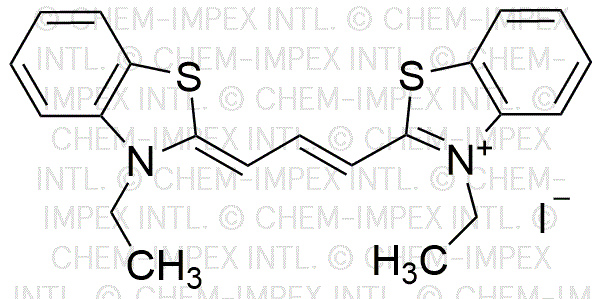3,3'-Diethylthiacarbocyanine iodide is widely utilized in research focused on:
- Fluorescent Imaging: This compound is commonly used as a fluorescent dye in biological imaging, allowing researchers to visualize cellular structures and processes with high sensitivity and specificity.
- Flow Cytometry: It plays a critical role in flow cytometry applications, where it helps in the analysis of cell populations by providing distinct fluorescence signals for different cell types.
- Labeling of Biomolecules: The dye is effective for labeling proteins and nucleic acids, facilitating studies on molecular interactions and dynamics in various biological systems.
- Photodynamic Therapy: In medical research, it is explored for its potential use in photodynamic therapy, where its fluorescence can activate therapeutic agents to target and destroy cancer cells.
- Environmental Monitoring: This compound can be applied in environmental science for detecting pollutants, as its fluorescent properties allow for the tracking of contaminants in water and soil samples.
General Information
Properties
Safety and Regulations
Applications
3,3'-Diethylthiacarbocyanine iodide is widely utilized in research focused on:
- Fluorescent Imaging: This compound is commonly used as a fluorescent dye in biological imaging, allowing researchers to visualize cellular structures and processes with high sensitivity and specificity.
- Flow Cytometry: It plays a critical role in flow cytometry applications, where it helps in the analysis of cell populations by providing distinct fluorescence signals for different cell types.
- Labeling of Biomolecules: The dye is effective for labeling proteins and nucleic acids, facilitating studies on molecular interactions and dynamics in various biological systems.
- Photodynamic Therapy: In medical research, it is explored for its potential use in photodynamic therapy, where its fluorescence can activate therapeutic agents to target and destroy cancer cells.
- Environmental Monitoring: This compound can be applied in environmental science for detecting pollutants, as its fluorescent properties allow for the tracking of contaminants in water and soil samples.
Documents
Safety Data Sheets (SDS)
The SDS provides comprehensive safety information on handling, storage, and disposal of the product.
Product Specification (PS)
The PS provides a comprehensive breakdown of the product’s properties, including chemical composition, physical state, purity, and storage requirements. It also details acceptable quality ranges and the product's intended applications.
Certificates of Analysis (COA)
Search for Certificates of Analysis (COA) by entering the products Lot Number. Lot and Batch Numbers can be found on a product’s label following the words ‘Lot’ or ‘Batch’.
Numéro de catalogue
Numéro de lot/série
Certificates Of Origin (COO)
This COO confirms the country where the product was manufactured, and also details the materials and components used in it and whether it is derived from natural, synthetic, or other specific sources. This certificate may be required for customs, trade, and regulatory compliance.
Numéro de catalogue
Numéro de lot/série
Safety Data Sheets (SDS)
The SDS provides comprehensive safety information on handling, storage, and disposal of the product.
DownloadProduct Specification (PS)
The PS provides a comprehensive breakdown of the product’s properties, including chemical composition, physical state, purity, and storage requirements. It also details acceptable quality ranges and the product's intended applications.
DownloadCertificates of Analysis (COA)
Search for Certificates of Analysis (COA) by entering the products Lot Number. Lot and Batch Numbers can be found on a product’s label following the words ‘Lot’ or ‘Batch’.
Numéro de catalogue
Numéro de lot/série
Certificates Of Origin (COO)
This COO confirms the country where the product was manufactured, and also details the materials and components used in it and whether it is derived from natural, synthetic, or other specific sources. This certificate may be required for customs, trade, and regulatory compliance.


